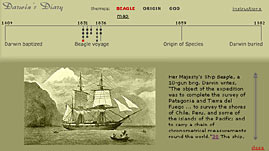Charles Darwin's life represented the essence of science. He was naturally curious and reflective and a keen observer who was always gathering evidence to explain the world around him. Even before Darwin stepped onto the
Beagle, he was an experienced naturalist. He spent much of his early life outdoors observing nature and during college had many scientists as mentors who engaged him in long conversations about science.
But the voyage of the
Beagle was the turning point in Darwin's life. It gave a breadth and depth to his experience that was invaluable to his later thinking. During the five-year journey of the
Beagle (1831-1836), Darwin spent only 18 months at sea. His curiosity, coupled with his frequent bouts of seasickness, inspired him to take long expeditions exploring the natural history and geology of Sough America, the Galapagos Islands, Tahiti, and Australia. Darwin made careful observations and looked for patterns wherever he went. His key observations about the diversity and distribution of species spurred his thinking for
On the Origin of Species by Means of Natural Selection.
Darwin wrote letters to his mentors and sent his collections home throughout his journey. By the time Darwin stepped of the
Beagle, he was already recognized by the scientific community for his expertise.
Darwin spent 20 years gathering evidence and writing about his theory before he published it. He anguished over the controversy it would create in Victorian England. And, if the naturalist Alfred Wallace hadn't come to similar conclusions and written to Darwin for help in presenting them, it might have been even longer before the world heard about
On the Origin of Species.


 Loading Standards
Loading Standards Teachers' Domain is proud to be a Pathways portal to the National Science Digital Library.
Teachers' Domain is proud to be a Pathways portal to the National Science Digital Library.
